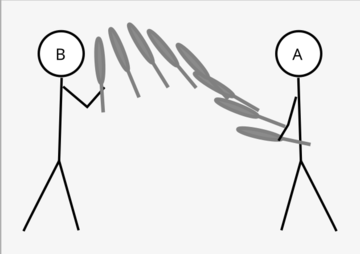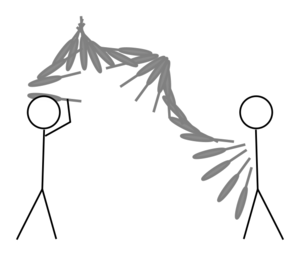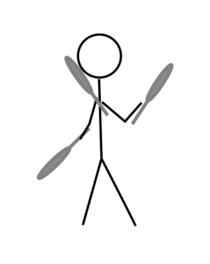Main Page: Difference between revisions
| Line 119: | Line 119: | ||
* [[Maybe]] |
* [[Maybe]] |
||
* [[Not likely]] |
* [[Not likely]] |
||
* [[Only Sunday with good weather]] |
* [[Only on Sunday with good weather]] |
||
7 club why nots: |
7 club why nots: |
||
Revision as of 14:32, 30 August 2022
The goal of this wiki is to offer "learning paths", of similar patterns with increasing difficulty.
There are different types of difficulty, so there is more than one starting point for each type of throw. Entry points with no/little experience all start with "Beginning with"
The beginnings (mostly) use only one throw type. When that throw has been practiced in different patterns, we start mixing different throw types.
Entry Patterns
These patterns are suitable for beginners. It helps a lot if one juggler is more experienced. If you mostly did patterns like 4-count some of the later patterns can still be of interest.
"Selfless Passing" (Zips and Passes)
Theory
a.k.a "what do all the numbers mean".
You have already seen numbers being used to describe the pattern and to create the animation. Feel free to read about theory whenever you get curious about what they mean.
Most patterns can be described best by a juggling math called Siteswap, and from that it is possible to do animations and tell passers what they have to do and how they have to start the pattern. You don't need to know how this works to juggle the patterns, but you will constantly see traces of the theory being used throughout the pages and at some point understanding will be helpful. This is described here:
- Entry point Siteswap
Zaps and Selfs
This is a good start into patterns with zaps and selfs, because the zip-self can just be substituted with doing nothing:
- Breakfast at Tiffany's zap-self-zip-self-self 56662
- Dead bunny and killer bunny 5-club 2-counts with zaps
The next patterns already mix high selfs and low zaps:
Single Passes and Selfs
6 club Half-Synchronous patterns (right hand of both jugglers throws at the same time), a.k.a "normal passing":
- 6-club 4-count
- 6-club 3-count
- 6-club 2-count
- 6-club 1-count
- 6-club PPS - Pass Pass Self
- 6-club Chocolate bar - PPSS
- 6-club Vanilla bar - PSSP
"Jim's" version of those patterns:
- 6-club Jim's 4-count
- 6-club Jim's 3-count
- 6-club Jim's 2-count - 77466
- 6-club Jim's 1-count
- 6-club Jim's PPS
Double Passes
- early double - in 4-count, 3-count, 2-count, etc?
- late double - in 4-count, 3-count, 2-count
- Throwing the first double passes - self-pass
- pass-self vs dpass-zip 7962
- doublepass-zip <4p|1><1|4p>
- dpass self zip self zip - 96622
- PZPZPZZ (doubles) - 9229922
- [[7-club 2-count <4p|3><3|4p>]]
Heffs in Solo Patterns - 4 club exercises
Recommended solo-patterns before you start:
- solo 423
- solo 40 - two clubs in one hand with doubles
- solo 441
- solo 4 clubs with doubles
Heffs in Passing Patterns
Tricks, typically done in 4-count, 3-count, etc.
First patterns with a heff - 5 club why nots
The Why not Family - 6-7 clubs
7 club why nots:
Double Selfs in Solo Patterns // Learning the 5 Ball Cascade
The "normal" 5 club cascade is juggled with double selfs. Usually long before that you learn to juggle 5 balls.
The patterns for practicing double selfs and for preparing you for each 5-object pattern are mostly the same.
Triple Selfs in Solo Patterns
Popcorns (Heffs or Triple selfs)
Doubles vs Passes
- Dpass,Self vs. Pass,Zip - 7926
- DP DP Z DP ZZ vs. P Z Z P P Z - 979222972722
- DP DP DP DP DP DP Z vs. P P Z P P P
Here Be Dragons - The Quest for the Holy Grail
A dragon is a double pass followed by a zap. They both arrive at the same hand, the zap first.
- 92522
- baby dragon 756
- dragon - black beast of aaaarg - 945
- dragon cat - 95524
- 97522
- Holy Grail - 975


